
Le Flore County is a county located along the eastern border of the U.S state of Oklahoma. As of the 2010 census, the population was 50,384. Its county seat is Poteau. The county name honors a Choctaw family named LeFlore, which is part of the Fort Smith, AR-OK Metropolitan Statistical Area. The United States District Court for the Eastern District of Oklahoma is the federal district court with jurisdiction in Le Flore County.
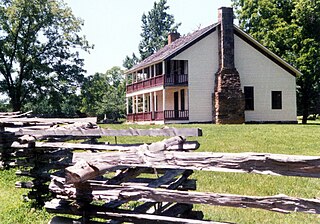
Pea Ridge National Military Park is a United States National Military Park located in northwest Arkansas near the Missouri border. The park protects the site of the Battle of Pea Ridge, fought March 7 and 8, 1862. The battle was a victory for the Union, and helped it gain control of the crucial border state of Missouri.

Hendrix College is a private liberal arts college in Conway, Arkansas. Approximately 1000 students are enrolled, mostly undergraduates. While affiliated with the United Methodist Church, the college offers a secular curriculum and has a student body composed of people from many different religious backgrounds. Hendrix is a member of the Associated Colleges of the South.

Hillcrest Historic District is a historic neighborhood in Little Rock, Arkansas that was listed on the National Register of Historic Places on December 18, 1990. It is often referred to as Hillcrest by the people who live there, although the district's boundaries actually encompass several neighborhood additions that were once part of the incorporated town of Pulaski Heights. The town of Pulaski Heights was annexed to the city of Little Rock in 1916. The Hillcrest Residents Association uses the tagline "Heart of Little Rock" because the area is located almost directly in the center of the city and was the first street car suburb in Little Rock and among the first of neighborhoods in Arkansas.

The Arkansas Governor's Mansion is the official residence of the Governor of Arkansas and Arkansas' First Family. The mansion is located at 1800 Center Street in Little Rock, and is included in the Governor's Mansion Historic District, a district that is listed on the National Register of Historic Places.
Bell House or Bellhouse may refer to:

The University of Arkansas Campus Historic District is a historic district that was listed on the National Register of Historic Places on September 23, 2009. The district covers the historic core of the University of Arkansas campus, including 25 buildings.

Caddo Mounds State Historic Site (41CE19) is an archaeological site in Weeping Mary, Texas. This Caddoan Mississippian culture site is composed of a village and ceremonial center that features two earthwork platform mounds and one burial mound. Located on an ancient Native American trail later named by the Spanish as El Camino Real de los Tejas, the settlement developed hundreds of years before the arrival of Europeans and Africans to the region. Archaeologists believe the site was created in approximately 800 CE, with most major construction taking place between 1100 and 1300 CE.
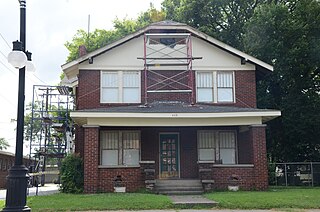
The First Presbyterian Church Manse is a historic church parsonage at 415 North Maple Street in North Little Rock, Arkansas. It is a two-story brick-faced structure, with a clipped-gable roof that has wide eaves with Craftsman-style exposed rafter ends and large brackets. A porch extends across the front facade, supported at the ends by brick piers, with a low brick balustrade on either side of the entry stairs. The house was built in 1927 as the official residence of the North Little Rock First Presbyterian Church's pastor. It was used to house ministers until the 1960s, and has since served a variety of functions, including youth center and law office.
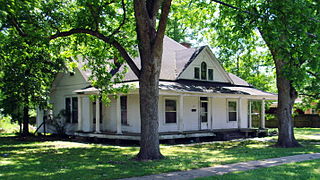
The Dr. J.D. Watts House is a historic house located at 205 West Choctaw Street in Dumas, Arkansas. It is a well preserved local example of a transitional Queen Anne/Colonial Revival residence.

The Thane House is a historic residence at Levy and First Streets in Arkansas City, Arkansas, overlooking the Mississippi River. The 1 1⁄2-story Craftsman style house was built for Henry Thane in 1909 to a design by Charles L. Thompson. It has a tile roof, with steeply pitched gable dormer on the front facade. The center entry is recessed, with a projecting bay to one side which is capped by a three-sided roof. The eaves have exposed rafter ends, and the front gable has false half-timbering.
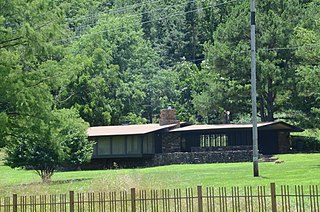
The Adrian Fletcher Residence is a historic house at 6725 Washington Road in Fayetteville, Arkansas. It is a single-story stone and wood structure with a shallow-pitched gable roof, set near the north side of an 80-acre (32 ha) parcel of land on the south side of East Huntsville Road. It is divided roughly into three sections, consisting of the main house, an open breezeway, and a carport. Built in 1957, it is a significant early work of E. Fay Jones, a protégé of Frank Lloyd Wright; it was his first commission completed after official recognition as an architect, and it became a showcase of his work, being written up and photographed for several magazines.
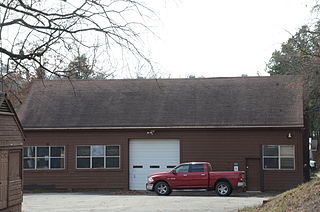
The Poteau Work Center is a utility building located at the Poteau District Headquarters of the Ouachita National Forest in Waldron, Arkansas. It is a rectangular single-story wood-frame building with gable roof, and is distinguished by centrally-located garage doors on each of its long sides. The building was, constructed about 1939 by a work crew of the Civilian Conservation Corps.

The Hemingway House is a historic house at 1720 Arch Street in Little Rock, Arkansas. It is a 2 1⁄2-story wood-frame structure, with complex massing and exterior typical of the Queen Anne period. A projecting bay on the left has a distinctive array of arched windows on the first floor, and a projecting trio of sash windows set in a bracket-supported surround, with a Palladian window in the gable above. The house colors were selected with the assistance of "Dr. Color," Bob Buckter, noted San Francisco color consultant, earning it a place in the 1994 book, America's Painted Ladies: The Ultimate Celebration of Our Victorians." The porch has delicate turned posts, in a distinctive tapered shape with flared bases and knobs at the top. The house was designed by the noted Arkansas architect Charles L. Thompson and construction was completed in 1894. The Hemingway House is one of the oldest examples of Thompson's work that is still standing.

The Frith-Plunkett House is a historic house at 8th and Main Streets in Des Arc, Arkansas. It is a well-proportioned two story wood frame structure, with a gable roof, weatherboard siding, and a foundation of brick piers. A Neoclassical two-story porch projects from the center of what is otherwise a typical I-house, giving it a distinctive Greek Revival character. Built in 1858, it is the oldest standing residence in the city.

Highway 80 is an east–west state highway in the Ouachita Mountains. The route of 49.87 miles (80.26 km) begins at AR 28 at Hon and runs east to AR 27 in Danville. The route is maintained by the Arkansas Department of Transportation (ArDOT).
Terry House may refer to:

The LeFlore County Courthouse, on Courthouse Square in Poteau in Le Flore County, Oklahoma, was built in 1926. It was listed on the National Register of Historic Places in 1984.

Terry House, on Terry Hill in Poteau in Le Flore County, Oklahoma, also known as Woodson House, was built in 1913. It was listed on the National Register of Historic Places in 1980.

The Poteau School Gymnasium-Auditorium, located at Walter and Parker Sts. in Poteau in Le Flore County, Oklahoma, was built in 1937. It was listed on the National Register of Historic Places in 1988.



















